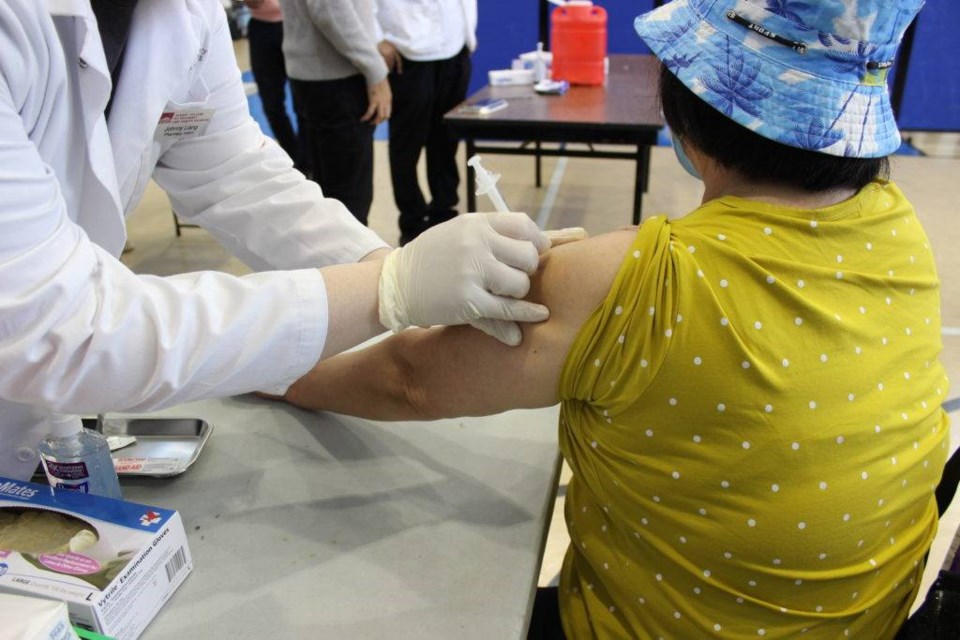Brooklyn
As of Monday, January 10 the 7-day positivity rate for COVID-19 is 19.8% in Brooklyn, down from 20.6% one week ago. The figures show that while Brooklyn and New York City as a whole are still battling a surge in COVID cases brought on by the new Omicron variant, we may have reached the peak of that surge.
Despite the encouraging figures, Health Commissioner Dr. Dave Chokshi indicated last week that more data was needed to confirm that. Meanwhile, some neighborhoods in the borough are returning positive COVID-19 tests at rates far above the average, including Bushwick/East Williamsburg's 11237 ZIP code where the 7-day positivity rate is a whooping 34.49%.
Brownsville's 11212 ZIP code, which has the highest positivity rate of our Brooklyn neighborhoods last week at 42.33%, has dropped to a transmission rate of 32.84%.
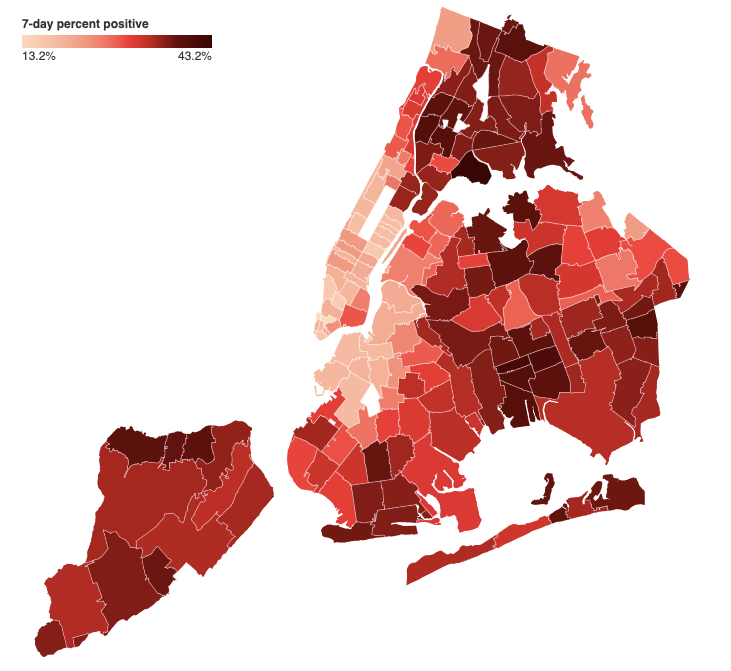
There have been 572,611 confirmed COVID-19 cases in Brooklyn and more than 11,000 deaths, according to The City’s COVID-19 tracker.

Despite the surge in COVID-19 numbers, students in Brooklyn and across the city returned to school last Monday, as newly sworn-in Mayor Eric Adams insisted parents “fear no” about their children’s safety. Despite that, absentee rates were high across the borough and city, with the Department of Education reporting only 72% attendance citywide on Thursday.
Adams said the city’s enhanced testing program for schools, which includes at-home tests to limit quarantines and doubles the number of students and staff randomly tested each week, will keep students, staff and families, while also putting an end to disruptions in the classrooms.
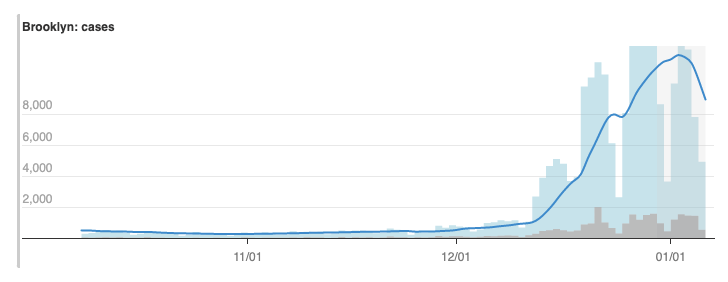
A number of the borough’s hospitals are reaching capacity in their ICU wards as caseloads rise. Woodhull is reporting 99% capacity, up from 95% seven days ago; Interfaith Medical Center is at 99%, up from 97% last Monday; NewYork-Presbyterian Brooklyn Methodist is at 88% down from 92%, Brookdale Hospital Medical Center is at 87% down from 88% and Kings County Hospital Center is at 80% down from 81%, according to The New York Times.
As of Jan. 3, 67% of eligible Brooklyn residents are fully vaccinated. To find a vaccination site near you, click here.
NYC
On Jan. 9 there were 40,526 new COVID-19 cases reported in NYC, up from 36,856 new cases just seven days earlier — a 110% increase over the past two weeks, The New York Times reports. December saw the highest number of COVID-19 cases reported in New York City since the outset of the coronavirus pandemic.
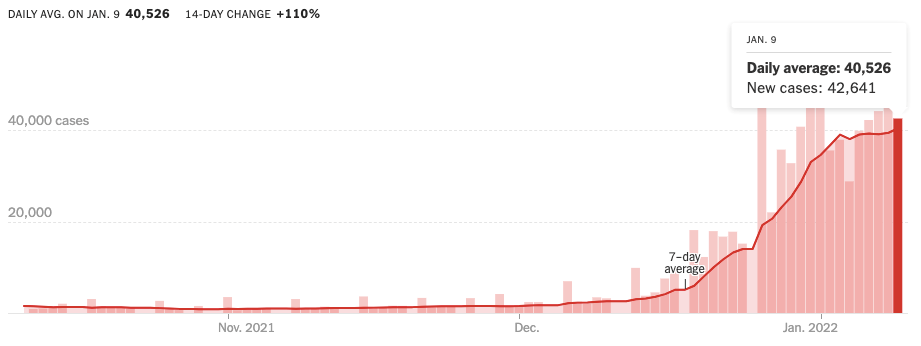
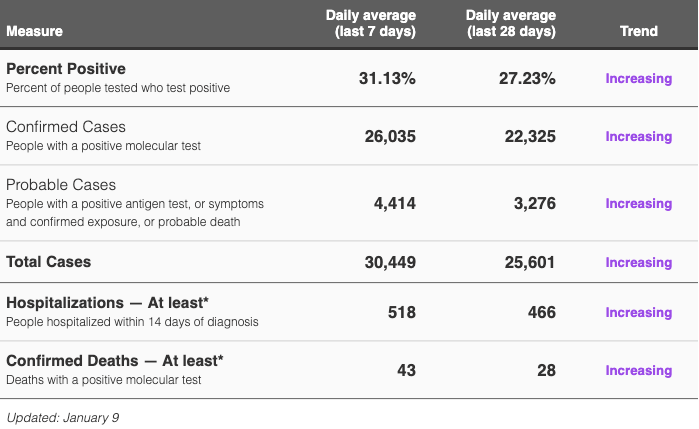
Despite the recent surge in COVID-19 cases in the city, there are positive indicators the spread of the Omicron variant may be slowing with the 7-day transmission and positivity rates trending downwards.
However, Omicron's high transmissibility has seen a number of breakthrough coronavirus cases and increasing hospitalization numbers, made up mostly of those who remain unvaccinated. The City is urging New Yorkers to get vaccinated and get their booster shots if eligible.
The City is increasing capacity at current City-run COVID-19 testing sites, establishing new sites and increasing availability of at-home rapid result tests to meet demand for COVID-19 tests. To find a testing site near you, click here.
New York State
As of Jan. 9, the daily positivity average for New York State was 21.71%, up from 20.9%, seven days earlier, according to state data. 11,747 New Yorkers were hospitalized with COVID-19 on Jan. 9, up from 8,773 a week earlier.
Governor Kathy Hochul urged New Yorkers to get the second dose of the vaccine and booster if eligible, "get your children vaccinated if you haven't already, wear your mask, and stay home if you're feeling unwell."
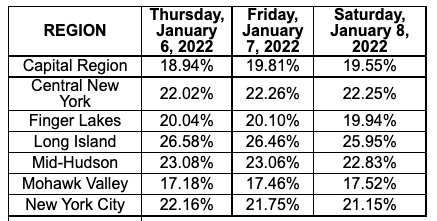
She said the State had ordered an additional 12 million tests last week, bringing the total tests ordered to 49 million. This week, the state is opening four additional MTA testing sites. Find a testing location near you.
Hochul announced last week a first-in-the-nation booster requirement for health care workers, and said more information would be coming soon.
She also announced new requirements for nursing home visitors, with the aim of keeping visitors and residents safe. Starting Wednesday, visitors must wear "surgical"-type masks and have a negative COVID test within 24 hours of visiting.
According to the CDC as of Jan. 9, 72.4% of eligible New Yorkers are fully vaccinated. The state has partnered with local health departments and community partners to launch over 40 new pop-up vaccination sites across the state. Learn more and find a pop-up site.
Now through January 15, businesses must require either proof of vaccination or mask-wearing indoors for everyone on their premises due to a statewide mandate. Find answers to frequently asked questions about the temporary requirement.
Hochul said for those wondering how long to wait to get a COVID-19 vaccine after having the virus, the CDC advised that those who had recovered from their illness, met the criteria for discontinuing isolation and were without symptoms could be vaccinated.
She added that new guidance recommended booster doses for all New Yorkers ages 12 and older. The guidance, following action by the CDC, recommends that people, including the newly authorized 12-15 year-old age group, who received the Pfizer-BioNTech vaccine should receive a booster dose at least five months after their second dose; the previous recommended interval was at least six months.
In addition, moderately to severely immunocompromised 5-11-year-olds can receive an additional primary dose of the Pfizer-BioNTech vaccine 28 days after their second dose. At this time, only the Pfizer-BioNTech COVID-19 vaccine is authorized and recommended for children ages 5-11.
All state mass vaccination sites are now offering Pfizer COVID-19 vaccine booster doses for New Yorkers 12 years of age and older, as well as third doses for immunocompromised people 5 years and older. For more information on boosters and additional doses, see the State's dedicated page here.

